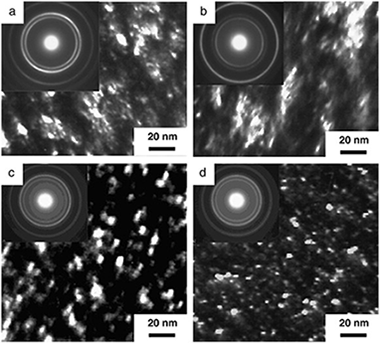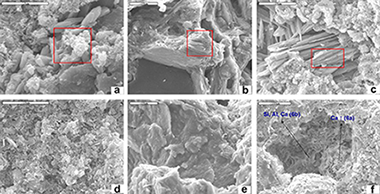Artículos SCI
2010
2010
Materiales y Procesos Catalíticos de Interés Ambiental y Energético
Operando XAS and Raman study on the structure of a supported vanadium oxide catalyst during the oxidation of H2S to sulphur
Holgado, JP; Soriano, MD; Jimenez-Jimenez, J; Concepcion, P; Jimenez-Lopez, A; Caballero, A; Rodriguez-Castellon, E; Nieto, JMLCatalysis Today, 155 (2010) 296-301
Show abstract ▽
The modification of crystalline phases of a vanadium oxide supported on mesoporous zirconium phosphate during the partial oxidation of H2S to sulphur has been studied by using an operando Raman-GC approach and XAS in reaction conditions. The catalyst, mainly presenting crystalline V2O5, is transformed during the oxidation of H2S at 200 degrees C, presenting crystals of V4O9, which is identified by the presence of a band at ca. 900 cm(-1) in the Raman spectra (using a 785 nm line of an Argon ion laser) and by the presence of a pre-edge at 5469.8 eV (and a main-edge at 5482.2 eV) in XANES spectra. At the same time, it is observed a high conversion of H2S to sulphur (the main reaction product) and SO2 (as minority). Both activity and selectivity depend on the time on stream. In this way, the selectivity to SO2 decreases from ca. 5 to 1% with the time on stream. This change could be explained on the basis of the nature of V-species: the initial presence of V5+-O-V5+ pairs and the appearance of V5+-O-V4+ pairs at high time on stream.
Octubre, 2010 | DOI: 10.1016/j.cattod.2010.02.050
Materiales Nanoestructurados y Microestructura
Si-doped multifunctional bioactive nanostructured films
Shtansky, DV; Gloushankova, NA; Sheveiko, AN; Kiryukhantsev-Korneev, PV; Bashkova, IA; Mavrin, BN; Ignatov, SG; Filippovich, SY; Rojas, CSurface and Coatings Technology, 205 (2010) 728-739
Show abstract ▽

Si-doped multifunctional bioactive nanostructured films (MuBiNaFs) were deposited by DC magnetron sputtering of composite TiC0.5 + CaO + Si (A) and TiC0.5 + CaO + Si3N4 (B) targets produced by self-propagating high-temperature synthesis method. The films were characterized in terms of their structure, elemental and phase composition using X-ray diffraction, scanning and transmission electron microscopy, electron energy loss spectroscopy, glow discharge optical emission spectroscopy. Raman, and IR spectroscopy. The Ti-Si-Ca-P-C-O-(N) films consisted of TiC(N) as a main phase with a minor amount of TiOx, SiNx, SiOx, SiC, and CaO phases probably mainly in amorphous state at the grain boundaries and COO- groups on the film surface. The excess of carbon atoms in the Ti-Si-Ca-P-C-O-N film (target A) precipitated in a DLC form. The films showed hardness in the range of 26-31 GPa, reduced Young's modulus of 200-270 GPa, and high percentage of elastic recovery of 60-71%. The best Ti-Si-Ca-C-O-N films exhibited low friction coefficient both in physiological solution and Dulbecko modified Eagle medium with fetal calf serum, hydrophilic properties, improved electrochemical characteristics, and excellent impact resistance. Nevertheless, the wear resistance of the Ti-Si-Ca-C-O-N films against Al2O3 ball was lower compared with the best Si-free MuBiNaFs. In vitro studies showed that the Si-doped Ti-Ca-C-O-N films possess improved osteoconductive characteristics during early stage of cell/material interaction. The film surface was highly adhesive for IAR-2 epithelial and MC3T3-E1 osteoblastic cells. The films revealed a high level of biocompatibility and biostability in experiments in vivo. The Ti-Si-Ca-C-O-N film (target A) did not show any bactericidal activity during cultivation of bacterial strains both on solid and in liquid Luria Bertani mediums. The film did not reveal any bactericidal and toxic activity against macrophages and therefore did not change bacterial status and defence system of macro-organisms.
Octubre, 2010 | DOI: 10.1016/j.surfcoat.2010.07.063
Hydraulic structures of the Roman Mithraeum house in Augusta emerita, Spain
Robador, MD; Perez-Rodriguez, JL; Duran, AJournal of Archaeological Science, 37 (2010) 2426-2432
Show abstract ▽

This paper deals with some of the hydraulic structures of Augusta Emerita (Merida, Spain), specifically those found in the Mithraeum House. In particular, we describe and characterise the hydraulic mortars and coatings of the viridarium water channel. The recipient of the channel was covered with two hydraulic mortars and a finishing coating. Hydrated lime was used as binder. Calcite grains with different morphology have been observed in the mortars studied. The siliceous aggregate was composed of quartz, mica and feldspars. Ceramic fragments, which were added to the mortar to improve its hydraulic properties, were composed of quartz, mica, iron oxides, anorthite and an amorphous phase; aluminium-iron silicates were used as raw materials for their manufacture. We discuss the interactions between the hydrated lime and the surface of the ceramics in the mortars.
Octubre, 2010 | DOI: 10.1016/j.jas.2010.05.003
Materiales Nanoestructurados y Microestructura
Microstructural study of the LiBH4-MgH2 reactive hydride composite with and without Ti-isopropoxide additive
Deprez, E; Justo, A; Rojas, TC; Lopez-Cartes, C; Minella, CB; Bosenberg, U; Dornheim, M; Borrnann, R; Fernandez, AActa Materialia, 58 (2010) 5683-5694
Show abstract ▽

An exhaustive microstructural characterization is reported for the LiBH4-MgH2 reactive hydride composite (RHC) system with and without titanium isopropoxide additive. X-ray diffraction with Rietveld analysis, transmission electron microscopy coupled to energy dispersive X-ray analysis, selected-area electron diffraction and electron energy loss spectroscopy are presented in this paper for the first time for this system for all sorption steps. New data are reported regarding average crystallite and grain size, microstrain, phase formation and morphology; these results contribute to the understanding of the reaction mechanism and the influence of the additives on the kinetics. Microstructural effects, related to the high dispersion of titanium-based additives, result in a distinct grain refinement of MgB2 and an increase in the number of reaction sites, causing acceleration of desorption and absorption reactions. Considerations on the stability of phases under electron beam irradiation have also been reported.
Octubre, 2010 | DOI: 10.1016/j.actamat.2010.06.043
Propiedades mecánicas, modelización y caracterización de cerámicos avanzados
Superplasticity in nanocrystalline ceramics: pure grain boundary phenomena or not?
Dominguez-Rodriguez, A; Gomez-Garcia, D; Castillo-Rodriguez, M; Zapata-Solvas, E; Chaim, RInternational Journal of Materials Research, 101 (2010) 1215-1221
Show abstract ▽
Superplasticity in ceramics has been the subject of intense research activity for the last two decades. Quite recently, the fabrication of fully dense nanocrystalline oxides with grain size below 100 nm enabled examination of their superplastic behaviour. This work presents a critical analysis of the plasticity of two important nanostructured oxide systems: MgO and yttria tetragonal zirconia polycrystals. A thorough comparison of their plastic deformation reveals that nano-structuring may be a necessary, but not a sufficient condition for superplasticity in ceramics as commonly assumed. Instead, the changes in the chemical composition and the transport properties, through the bulk and at grain boundaries, versus temperature and grain size can induce a rich variety of mechanical responses.
Octubre, 2010 | DOI: 10.3139/146.110401
- ‹ anterior
- 368 of 422
- siguiente ›














